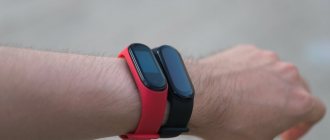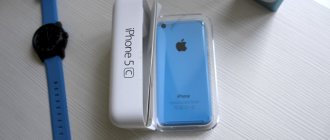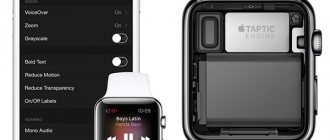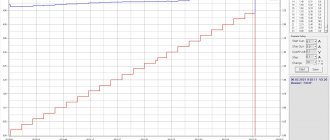Equipment
In a rather small box, made in the corporate style of Google, you can find, respectively, a smartphone, a USB cable, as well as a unit for connecting to a power outlet and further charging the device. Not much, yes, but I had headphones before purchasing them, so even if they are not included in the package, it’s not a problem at all, and besides, many manufacturers shove ordinary plastic things in there, which they also call headphones. Among the rest, there are, of course, various instructions and a special clip for opening the SIM card tray.
The box itself has a bright appearance and especially stands out among the rest, since the overall design of the search giant is quite recognizable. In any case, I'm glad that Google has finally decided to change the design of the boxes for branded mobile devices. What I mean is that you just have to remember even the same box in which the first generation ASUS Nexus 7 tablet was sold - gray gloomy colors, sadness, sadness and life is decaying. In new devices, the boxes are excellent and bright, so in this case I won’t say a word about complaints.
Nexus 6
With the Nexus 6, the saying “Nexus is powerful and cheap” is no longer relevant. It’s sad that the company decided to move away from such a pricing policy, because it’s already clear that by doing so Google will kill sales of this device, and what were they thinking? To create a solid base of devices with your own philosophy, and then instantly destroy everything, destroy all previous aspirations, what is all this for? Lately, Google has been behaving very strangely: these are the failed projects Google Glass, Android One, Android Silver, and the release of the expensive Nexus 6 and Nexus 9. There are big doubts about the future of the company, is it so bright? Don't think. Nexus has always been associated with a cheap device, will people buy cheap for expensive, even if it is a top-end offering? Definitely not. There is no point in predicting sales, and it is clear that they will be very low. Nexus 6 was created now in collaboration with Motorola, and received top-end characteristics for those times: a Snapdragon 805, a 13-megapixel camera, and 3 GB of RAM. However, is this so important when supplies of a smartphone are specifically limited, when it is difficult to buy even in the West, when its price is a whopping $649 for a 32 GB model. Taking into account the shortage, the price from resellers will increase to 800-900 dollars, which is not at all encouraging.
Appearance and ease of use
The appearance of the LG Nexus 5 smartphone is quite good, but still Google did not introduce any proprietary design delights in order to distinguish its new flagship from its other peers. It is, of course, worth noting that the case has recently gone on sale in a new color, as well as the “Nexus” brand inscription on the back panel, similar to the second generation ASUS Nexus 7 tablet. Thus, the search giant is trying to create a unified design for its mobile devices, and I don’t think that’s a bad thing at all.
The flagship body is made of glass and soft touch plastic. I would like to note that with daily use, the back panel gets seriously dirty, but I don’t attach much importance to this, since in order to identify these very traces of fingerprints and other things, you need to take a special look and find fault, they say, the case sucks and the like. Yes, some individuals do this, but I am not one of them. It is worth paying tribute to the manufacturer, because scratches do not remain on the back panel even if this is done deliberately - which is good news. The color of the case is true black, it looks strict and stylish, and feels comfortable in the hands. True, previously I had not had the opportunity to twirl a 5-inch device in my hands and at first it was a little spadey for me, but I soon got used to it. It doesn’t try to slip out of your hands, which is very, very pleasing. The build quality is undoubtedly excellent, and for the price it’s absolutely gorgeous. In general, there is only one minor drawback - the buttons for controlling the volume and turning the device on/off, so to speak, “move.”
There are no control keys under the display, because they are all displayed on the screen - Google has adopted this type of control for the Android operating system since the time of Android 4.0 Ice Cream Sandwich. For some, the extra space under the screen in their opinion may be a disadvantage, but there is an LED hidden there that notifies the user of messages, calls and other events, so again I do not consider this really important. There is space under the screen, but it is occupied by a useful thing, and there is absolutely nothing wrong with that.
Above the screen there is a conversational and quite loud speaker, a front camera with a resolution of 1.3 megapixels (which, by the way, takes quite good quality photos) and standard sensors.
On the rear panel you will find an 8-megapixel camera with LED flash and optical image stabilization, Nexus branding, the manufacturer's logo (LG) and certification data.
On the bottom edge there is a connector for connecting USB and further charging, or synchronizing with a computer, the main speaker and microphone - both of them are hidden under the mesh and this whole picture looks like stereo speakers, but no such luck. On the side edges, standard volume control and smartphone on/off buttons take their place. It is worth noting that the material from which they are made is ceramic, which is why they are very pleasant to the touch, and the pressing stroke is clear and even audible if you listen. The only downside is what I already mentioned some time ago - the movement of these very buttons, but it doesn’t matter - in everyday use this is not noticed and does not catch attention. On the top edge there is only a 3.5 mm headphone jack.
The last thing I would like to say is that the LG Nexus 5 smartphone cannot be called a thick stick; its body is quite thin and for this reason it will fit perfectly in the pocket of a jacket or work jeans. You will not feel any discomfort when wearing.
About the benefits of reading between the lines
A buyer far from the world of smartphones, intrigued by such an introduction, will probably inquire about the price of the model, rightly believing that a flagship by default cannot be too cheap. But for the Nexus 5 in large retail chains they are not asking that much these days - a little less than 19,000 rubles, and if you are satisfied with the “gray” model, then another couple of thousand less. What's the catch, you ask? In the date of appearance of the smartphone on the market and the proposed technical characteristics.
LG smartphone taken under Google's wing
We will talk about the second in more detail below, but the first requires additional clarification. Stores offering the Nexus 5 are in no hurry to inform potential buyers that it was released on the market at the end of 2013, which is not so little by IT standards. Consequently, a smartphone can be considered a flagship or a new product with great reservations, and the natural desire to save money can play a cruel joke on enthusiastic fans. But in order to close the financial topic and move on to the analysis of technical characteristics, I would like to clarify that its venerable age did not in any way affect the consumer attractiveness of the model. Yes, it does not shine with a lot of innovations or parameters brought to the peak, but if you are looking for a phone and not a stand for setting records, you should like the Nexus 5.
Venerable age did not affect the consumer attractiveness of the model
Screen
The flagship LG Nexus 5 is equipped with a very bright 5-inch IPS display with a resolution of 1920x1080 pixels (FullHD). This is not to say that the display conveys unnatural colors or that its brightness is insufficient for outdoor use, but there are disadvantages - viewing angles. When specially viewed from different angles, you may see color distortion as well as overall loss of color. I don’t know about you, but I use a smartphone holding it in my hands at a distance of approximately 20 centimeters and with slight turns the display displays a picture of sufficient clarity and color. The brightness range, by the way, is high. When set to maximum brightness, the screen remains readable even in direct sunlight. The minimum brightness level is not too high for reading in the dark, but it’s not too low either - it seems to be somewhere in between. In any case, in complete darkness you may experience some discomfort, but if even a ray of light from the next room falls into yours or your floor lamp is on, reading comfort at minimum brightness is guaranteed.
Clarity is undoubtedly at a high level, because the display pixel density is 445 ppi. On a 5-inch display, you won't be able to find a pixel, which means the picture will be clear and bright, and it is. When reading the text, it doesn’t dazzle your eyes, because it feels like a magazine. If you have another mobile device with a display resolution lower than LG Nexus 5, moving from it to the second one you will experience some discomfort and it will be clearly noticeable. Overall, the screen is excellent for its price. Color reproduction is decent, and the average user is unlikely to watch movies at an angle of 180 degrees. The sensor supports more than ten clicks and the response is very fast. Just by starting to point your finger at an object displayed on the screen, the smartphone will begin to understand what you want. I give the sensor 5 points and 5 (a rating system would not hurt).
System
As you already know, or maybe you don’t know, the LG Nexus 5 smartphone was officially presented based on the new Android 4.4 KitKat operating system, which acquired a slightly redesigned user interface, support for working with devices with at least 512 MB of RAM, as well as ability to select application execution environment - Dalvik or ART. Naturally, you won’t find any shells or interface add-ons that take up a cosmic few gigabytes of built-in memory in Google’s flagship - it is equipped with a pure interface as the search giant sees it. I personally have loved the design of Holo since the release of the Android 4.0 Ice Cream Sandwich operating system, and I continue to do so to this day. Yes, there are some mistakes in the elements, but over time, I hope all this will be improved.
It is worth noting that the smartphone is equipped with a launcher that is no longer exclusive to it, called Google Now Launcher, or for Russian users simply Google Start. Let me remind you that some time ago Google officially finalized it and published it in its own Google Play application store. Currently, it is available for installation only on Google Nexus devices, as well as a special edition called Google Play Edition. But don't worry - there will be an update in the near future that will bring support for other mobile devices based on the Android operating system. Here are a couple more screenshots for you.
Nexus 7 (2012)
In 2011, Google released Android 3.0, which was intended exclusively for tablets, but it was only implemented in 2012 with the release of Nexus 7 under the Asus brand, with which Google entered into a cooperation agreement. The tablet offered was the rather well-promoted Tegra 3, which focused on the gaming part with its own application store adapted for Tegra devices. In fact, the processor received a bad reputation and was subsequently not used anywhere except on the One X. In addition, the “tablet” received a 7-inch display with a resolution of 1280 x 720 and 1 GB of RAM, but the key difference was the low price, which was only $200. Nexus 7, like all Nexus tablets, received Android 5.0 Lollipop.
Performance
The LG Nexus 5 smartphone has the following technical characteristics: quad-core Qualcomm Snapdragon 800 processor with an operating frequency of 2.3 GHz, 2 GB of RAM, 16/32 GB of internal memory (without a slot for MicroSD memory cards), and Adreno 330 acts as a graphics accelerator .
This hardware, in my opinion, will be relevant for the next year and a half, remember the same Samsung GALAXY S5, which is practically no different in terms of hardware from the competitor I am reviewing from Google. Naturally, all the toys are included, be it the latest Real Racing 3, Dead Trigger 2, Asphalt 8 and others. In some ways, the brainchild of the search giant can be called a gaming device, but there are some drawbacks here, of course. When rubilovo in cool toys for more than half an hour, the back panel becomes a frying pan for scrambled eggs preparing for frying on the stove - this is figuratively speaking, so do not take it seriously. I managed to achieve a heat rating of 43 degrees, while the maximum level for the Qualcomm Snapdragon 800 series processor is 45 degrees. This is perhaps a significant drawback if you plan to play the latest 3D games every day, but there is another one - the battery, but more on that later. Now let's look at the results of the remaining benchmarks and tests.
Nexus S
512 thousand devices between the second quarter of 2011 and 2012 - these are the figures shown to us by the second generation of Nexus devices. This time, the manufacturer was the already well-known Samsung, which, it is worth noting, was chosen for a reason, because the release of the Galaxy S in June, which sold 24 million units, gave Google hope for the success of the second generation due to the popular and reliable brand. 512 thousand is some progress, but these are tiny numbers in comparison with the same Galaxy S. Meanwhile, the device did not receive a significant increase in performance, but the advantages include the most popular version of Android 2.3 Gingerbread, NFC, 16 GB of internal memory without support for MicroSD and 4 -inch AMOLED display.
Autonomy
Many complained about the battery of the LG Nexus 5 smartphone because its capacity is 2300 mAh and it is sorely not enough for everything: games, movies, music, surfing the World Wide Web and, of course, calls and messages. I'll tell you this: with my settings, the smartphone lasts one day or more (plus or minus a couple of hours). Of course, we won’t be able to do without proprietary tests, which were carried out for us by people in white coats. Thus, you can talk on third-generation networks for 16 hours 37 minutes, surf the Internet for about 4 hours 48 minutes, and watch movies for 6 hours.
As I already said, the smartphone only heats up when running heavy games and various benchmarks in general, which squeeze all the juice out of the processor and other components. You know, in winter it will serve you as a good home stove, but since winter has already passed in my city, it makes no sense for me to heat the device now. As for games, active hacking will last not to say that long - about three hours, to which you will answer: “ugh, the bottom, the battery sucks, but I wanted to buy it, now I won’t.” As you know, this is your opinion and I will not judge it. With my settings, let me remind you, the smartphone lasts one day. From eight in the morning, using calls, the Internet, a little music, a little games, the LG Nexus 5 begins to complain about the battery being discharged late at night (the battery falls asleep, the mafia wakes up, endlessly demanding a charger from you). Thus, I put it on charge at night - I use it in the morning, afternoon and evening, and then again for the second round. By the way, the runtime is installed by ART. After Dalvik, the increase in autonomy was significant.
Cameras
Google's fifth-generation flagship is equipped with an 8-megapixel sensor with optical image stabilization. There is also an LED flash, which, if necessary, fulfills its purpose perfectly. The camera takes high-quality and detailed photographs. Indeed, after the release of the minor update, the bugs from the camera were cut out - this is obvious. Autofocus, by the way, would do well to be a little faster, but while you stand and focus, the whole oil painting will flow into existence. When using the flash in low light conditions, the camera behaves well; focused objects are not overexposed. The front camera has a sensor with a resolution of 1.3 megapixels, but surprisingly the photos turn out to be very decent. In any case, it’s enough for video calls or conferences.
Objects are not overexposed, which is great
Macro photography is at a decent level, everything is clear and without blur
I decided to take a photo of my clumsy handwriting as text.
Photos from the front camera show good results. You can check out my cat playing with flowers in the kitchen
Bottom line
In my city, the LG Nexus 5 smartphone is sold in retail stores at a price of 17,990 rubles. I think the price tag is quite justified: stylish design, high-quality build, excellent hardware, good camera, support from Google. In general, I do not regret the purchase at all, the overall impression of use is only positive.
Pros:
- Design
- Powerful and relevant iron
- Bright and high-quality display
- Build quality
- Good cameras
- Excellent touch response
- Doesn't slip out of your hands
- OS support and updates from Google
Minuses:
- The buttons are shaking
- Dust lives between the glass and the frame
- Protruding camera module (very easy to scratch when placed on a flat surface)
- Middle speaker (at maximum volume it hisses a little, but no one canceled the detailed adjustment via the equalizer, which, by the way, I did not use)
- The case is easily soiled and collects fingerprints like a base.
- Autofocus could have been improved faster
The smartphone was provided by Ivan Shevelev for the best mobile portal.











